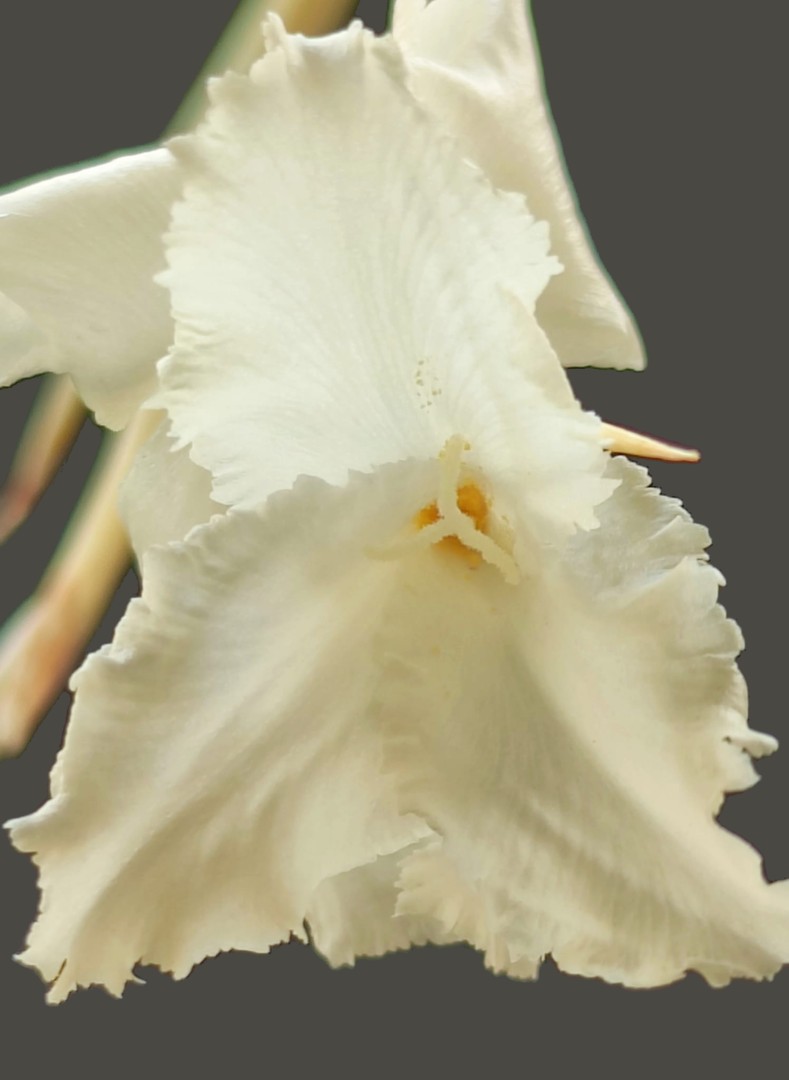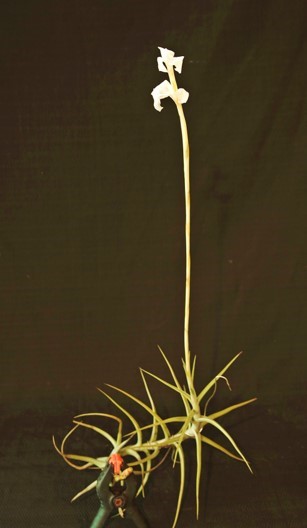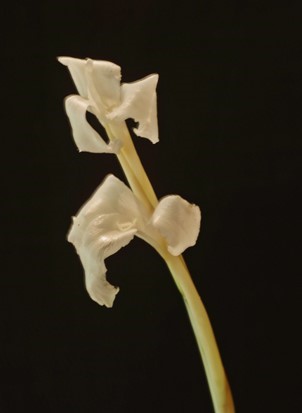









Translated by Derek Butcher
Plant saxicolous, caulescent, growing in groups, simple or barely branched stem, graceful up to 1 m long; erect or arched rigid stem;
leaves polystichous, rigid, erect or curved, amplexicaul, base 1.5-2.5 cm wide,
blades triangular lanceolate, 5-10-15 cm long, ensiform, grooved, laxly lepidote, rigid, acute apex;
spike few flowered, erect, 5-9 flowers, rachis glabrous, distichous, light yellow, bracts 5-10 cm long, navicular, complanate, linear acute, erect or arched apex, straw-covered bracteoles, 3-5 cm long.
Flowers perfumed, emerge from the axil of the navicular bracteola;
sepals glabrous, free, 3-4 mm long, triangular lanceolate, covered by the navicular bract, acute, nerved, glaucous;
petal white 5-10 cm long, linear, forming a tube, blades spatulate, 3-5 cm long, oval, subsymmetric, folded with a jagged margin;
stamens inside the tube formed by the petals, 5-7 cm long, abnormally folded, anthers 8 mm long, the stamens exceed the floral throat, 5 mm long, style trifid, arched, longer branches than the stamens;
capsule 3 cm long, brown carpels, with dark brown internal part, brilliant,
seeds 3mm long with the pappus 1 cm long.
It belongs to the section Aerobia Mez (Castellanos 1945) by having the stamens deeply included inside the tube formed by the petals, they do not reach the throat of the corolla, style longer than the stamens, symmetrical petals, the inflorescence when simple, distichous, flabellate. L.B. Smith (1977) treats this species as within the Subgenus Anoplophytum.
It is a plant that grows in the Riachos, saline lagoons, riverside forests of the Chaco, the humid plains of Paraguay (Salas Duenas et al 2004) also called humid Chaco, where they accumulate salts on the ground after periodic floods (Mereles & Degen et al 1992). The plant can resist periods under water. It flourishes in the summer, when the temperature is extreme, also the basin of the Riacho Yacare Sur and Campo María harbors great quantities of aquatic birds, and this species provides material to build the nests of many birds. In their natural environment it is graceful and flexuous, the stem easily fragments, when drying off in the herbarium samples become rigid and chartaceous.
The area of distribution of this species is restricted and its conservation is recommended as much by its evolutionary aspect as in its relationship with a great part of the components of its habitat.
It is kindred to Tillandsia diaguitensis Castell. and T. xiphioides, for the stem and leaf stem, the lack of a rhizome and the simple inflorescence and differs from these by having longer flowers as well as the scape. The scarcely existent mentioned material in the herbaria is poor and it does not help in defining the species. The types of both species have been studied. Smith (1977) mentions T. diaguitensis for Paraguay and this material corresponds to the new species.
I dedicate this species to Dra. Fatima Mereles Haidar, friend and colleague, indefatigable traveler in the Paraguayan Chaco, where we carry out ecological studies in the humidity for the most part of the time.
Material additional studied:
Paraguay. Dpto. Boqueron, Puerto Casado, T. Rojas 7512 (BA); Neuland, 14.VII.1992, Leg. R. Degen & F. Mereles 2646 (CTES, FCQ); LXII. 2003, Leg. F.R. Verena 60 (CTES); Filadelfia, 31. VIII.2004, Leg. A. Schinini 36524 (CTES)., Aldea Buena Vista, Riacho Yacare Sur, 22° 33'22.4" S, 59° 26'24.4" W 25.IX.2002, Leg. F. Mereles, L. Perez de Mola, S. Sede, K. Eliceche 8842 (CTES, FCQ); Estancia Santa Sofia, Riacho Gonzales, 6.III.1999, Leg. F. Mereles & M. Zoloaga 7497 (CTES, FCQ); Reserva privada "Campo Maria", Cooperativa Chortizer Komitee, 13.I.2007, Leg. C. Vogt 114 (CTES, FCQ, WU).
Dpto. Central, Asuncion, Cultivada procedente de Boqueron, XII. 1985, Leg. A. Schinini 24629 (CTES).